- Getting around Lijiang. Dont stay in the Old Towns more than 2 days, there is nothing to do. KRISS Oct 9, 2013 05:46
- 2013 Beijing Temple Fair BENNYLAU Feb 26, 2013 03:29
- Malaysian traveling from KUL - LAX vis Shanghai PVG ZATI_DY Jan 3, 2013 20:15
The Leaning Tower of Tiger Hill
- Views: 7356
- |Vote: 1 0
- |Add to Favorites
- |Recommend to Friends
Lofty Inclinations
It’s a well-known fact that the Chinese were up on their game in the department of inventing things immeasurably useful to mankind: from paper to the compass, porcelain to gunpowder. Even contrary to my students’ textbooks (put out by Cambridge University) the Chinese invented the printing press a good 300 years before that slouch Gutenberg set our 26-letter alphabet into movable type (he’s not really a slouch—I just called him that to set up my witty pun in the next paragraph).
So it won’t be any surprise to you when I tell you that the Pisans in Italy don’t actually have the market cornered in Leaning Towers. That’s right. The Chinese managed to incline their building prowess toward towers that don’t stand up straight more than 200 years before those in the Piazza dei Miracoli began their plans (though to this day the architect of the Tower of Pisa remains a mystery…could the master of both towers be one and the same—nationality…?)
Poet's Advice
On top of a 36 meter high man-made hillock on the outskirts of Suzhou (already known for its likeness to Italian scenery and structure) leans the seven-storied octagonal YunYan pagoda. Its rakish tilt is the main identifying feature (and attraction) of Tiger Hill, a scenic compound of over 3 acres steeped in history and mystique. Add to that a moat and some lore oddly reminiscent to some of the West’s most famous tales and you’ve got a place so cool that Chinese poets beseech you not to miss it.
If you do, you’ll never know how much you’ll regret it.
Of Myths and Men
Tiger Hill’s fame begins with the death of King He Lu in 496 BCE. He Lu was the founder of Suzhou and the King of the Wu people, in addition to being patron and initiator of the art forms and cultural intricacies that make Suzhou what it is today. After he died in battle against the Yue, his son Fu Chai buried him on the hill and returned three days later to find a white tiger guarding the mound.
From these mythical origins 2500 years of singular and separate icons of Chinese history have contributed to the mosaic of attractions found on Tiger Hill today. From the Sword Stone to the Temple of the Virtuous of Lady; the Leaning Tower to Sunzi’s practice grounds; a double well that Chinese Tea Aficionado Lu Yu drew water from to classical villa architecture and a Buddhist monastery. When I was a girl my imagination often ran off into impossible tales of heroism and legendry; poetry and romance. Tiger Hill is precisely the kind of place from which my imagination would never have returned.
...And Moats
Why is there a moat around Tiger Hill? It’s a good question to which I couldn’t find any answer other than the experiential fact that when you cross the bridge over the moat and enter the grounds of Tiger Hill you stop being a visitor and you become part of what you’re seeing. Moats are historical, interesting, demarcating. They isolate and include. And if you successfully cross over, you’re in. My experience of moats generally involved Europe, castles, and the Western species of dragons. The Chinese moat experience wasn’t much different—whether I was aware of it or not, I had transcended. Into a world where white tigers guarded souls and 3000 swords nourished the soil in their secreted and deathly location. Where poets wrote and Buddhists meditated and soldiers honed and concubines committed suicide and were given shrines—all because they were inspired.
Swords and Stone
Not long after you cross the moat, along the main artery up to the top of the hill, modestly sitting by the side of the path but notably marked by the swarm of tourists at its edge, lies the Sword Testing Stone. At first I thrilled at its likeness to Arthurian legend (my fantasies of castle lore lingering from the moat-crossing), but I was put duly in place by my Chinese companion, who reminded me that the hero of this story, He Lu, wasn’t pulling swords out of the stone, but simply testing their ilk by carving the stone up the middle with them. He was an incorrigible sword collector, acquiring more than 3000 in his lifetime as legend has it, which is why the Stone is so precisely sliced—all the way through—and yet still just one stone.
Before I encountered the Stone I thought it might have just been poetic license that metaphorically attached a stone which had been split by nature’s fits and renderings to the fabled King. But no, to my delight. The stone is much too precisely hewn to have been made by anything other than man. I had to believe the lore.
Embracing the Verdure, as they say
Facing the Stone lies the Verdant Mountain Villa, a four-tiered structure terracing the hillside. Each level is designed to expose a different panorama of ‘verdure’ to the eye. The first hall, and the lowest in altitude, is dubbed the “Urn-Embracing Hall”. You’ll have to see it for yourself to find out why, though I’m not making any promises. Next up, literally, is the “Pavilion of Inquiring the Spring” both figurative and literal. After that, the main level with two houses: “The Fine Cottage of Bright Billow” and the “Moonlight Arrival Pavilion”. Last, highest, and most austere is the “Hall for Seeing the Green Off”.
The Verdant Mountain Villa is just one of several villas and retreats constellating the hillside. It was built in 1884 by two of Suzhou’s reigning celebrities of the time. Over the dynasties, several famed personages (of local or national renown) built their own homages to verdure. Another good example is the Wangjing Villa, in which several bonsai trees stymie the eye with their impossibly controlled growth patterns.
Enough for a Thousand Men
About halfway up the hill is an expansive opening cobbled by giant boulders with tectonic-like rifts aptly named the “thousand man rock”. It was so named for the thousand monks who would gather here to listen to the teachings of their master. Nestled on the rock like birds flocked together, I can imagine they spent many an hour in the sunshine with the scenery stretching off before them and shade of trees all around. And just behind and above them, the pale knuckle of the Leaning Pagoda above the treetops. Today, it remains the central gathering spot for tourists to rest after summiting to the pagoda.
Depths of Knowledge
Up the knoll from there is the open courtyard deigned the Sunzi training grounds. Sunzi, the author of the Art of War, traipsed philosophically through battles somewhere before the Qin dynasty and after He Lu was buried under the white tiger’s paws. It is said that in this space he led followers along his path of thought and practice, though no one can really be sure. It’s also got a fantastic view of the whole wobbly water table that is Suzhou, off in the distance.
Beyond that, up some steep rocky stairs and over a sharply narrow ravine, sits a bridge with two identical wells bored into it. Legend has it that below the bridge, below the water that’s below the bridge, lie the 3000 swords of He Lu’s collection that went with him into the afterlife. But nobody really knows for sure: the slaves who dug up the earth and buried the swords were executed when their task was finished.
One thing’s for sure though: the well was constructed by Lu Yu, China’s head honcho in the tea department. He wrote the Cha Ching, the Gospel of Tea, and though his whole life he ran from the privies of the monastic life, he ended his days in the monastery on the slopes of Tiger Hill, basking in his fame and drawing up water from the wells from which, he proclaimed, was the third most ideal place to get water for tea-making.
To the Tower
The YunYan Pagoda—Tiger Hill’s Leaning Tower—hinging at about 3 and a half degrees to the northwest for over 400 years, is a spectacular stone structure where guards depressingly bark at you not to loiter within the building and where you constantly find yourself caught blocking someone’s family photograph. Built in the Northern Song dynasty, it was constructed as part of the monastery, a pinnacle at the top of the modest hill, beckoning people up the flanks of the slope. Spiritually precise, it is octagonal in shape and seven stories tall, and other than that the guards prevent you from taking in much else. There is, however, a very cool removable stone in the center of the floor where they yearly measure the building’s angle of repose.
If all this isn’t enough to pass a day in the Venice of the East, Tiger Hill is laced with paths that lead off into the open acreage unfestooned by man’s mark. You may be inspired to leave your own.
Just beware the moat.



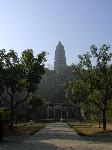

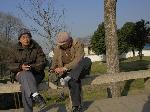
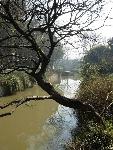

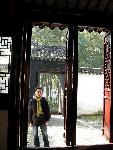
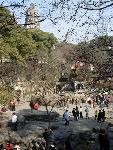
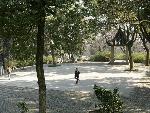
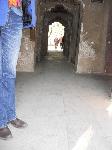
 Copyright © 1998-2026 All rights reserved.
Copyright © 1998-2026 All rights reserved.